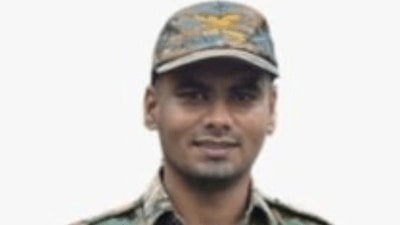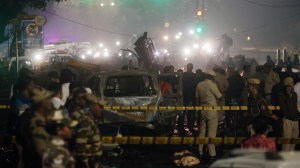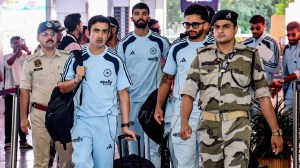The Hawk has landed
Filling a glaring hole in the Indian Air Force’s fighter-aircraft training programme and ending a debate that’s gone on for 20 yea...

Filling a glaring hole in the Indian Air Force’s fighter-aircraft training programme and ending a debate that’s gone on for 20 years, the Government today decided to acquire the Hawk Advanced Jet Trainer.
Under the Rs 8,000-crore deal with British Aerospace, India will get 66 aircraft, a fleet that will for the first time help IAF pilots bridge the gap between subsonic and supersonic aircraft. As of now, 17 countries, including the UK and the US, fly about 800 Hawk AJTs.
Hours after the Cabinet Committee on Security’s decision, Chief of Air Staff Air Chief Marshal S. Krishnaswamy told The Indian Express: ‘‘It is a timely decision that will boost the IAF’s training programme and the morale of the force.’’
‘‘India’s choice of Hawk is a measure of the quality of the aircraft and the value for money it offers,’’ said British Defence Secretary Geoff Hoon in a statement. ‘‘I look forward to a successful contract.’’
|
WHAT ELSE WAS OKAYED
|
|
• Purchase of six VIP jets from Embraer, Brazil |
Besides the AJT, defence purchases worth Rs 4,500 crore were also cleared (see box). This comes days after the Government was under fire in Parliament with the Opposition alleging that the armed forces were being ‘‘neglected’’ because Rs 9,000 crore was being returned unspent.
This year, however, the Defence Ministry will not only utilise the outlay but, officials said, even seek supplementary grants for advance payments for the deals cleared today.
The CCS, headed by Prime Minister A B Vajpayee, met this morning and decided to go ahead with the AJT after British Aerospace agreed to revise its cost down by Rs 300 crore.
An indication that the AJT was on the agenda came when Air Marshal Raghu Rajan, Deputy Chief of Air Staff and in charge of all acquisitions for the IAF, was invited to brief the CCS.
After the meeting, Defence Secretary Ajay Prasad, announcing the decision, said: ‘‘There were difficulties (in the deal) which is why the process took so long.’’
|
WHAT TRAINEE FIGHTER PILOTS WILL GET FOR RS 8,000 CRORE
|
|
• What is an AJT? Story continues below this ad • Why do we need it? This quantum jump from subsonic to supersonic aircraft is one of the prime reasons for accidents involving rookie pilots. Hawks will make more MiGs available for operational duty. Can be readied for combat duty whenever needed. • Why has it taken us so long? Plus price negotiation was a factor. The Hawk deal shut out other AJT contenders like the Czech-Boeing L-159, French Alpha and Russian MiG-AT. Story continues below this ad • Who else is flying this AJT? |
The deal involves outright purchase of 24 aircraft, with the remaining 42 to be manufactured by Hindustan Aeronautics Ltd. under license. India and Britian will also sign an inter-government agreement to ensure that the AJT fleet receives adequate product support from the original manufacturers and is sanction-proof.
While IAF pilots will move to the UK for training on the Hawk, the whole deal will be completed within six years of signing the contract.
In the running since 1982 when the MoD first sent feelers for an AJT, the Hawk 115Y had been a front-runner. Competition came from the French Alpha, Czech-American L-159B, Russian MiG-AT and YAK AJT, and an aircraft still being manufactured by Lockheed Martin.
In the end, as Prasad put it, ‘‘This decision fulfils one of the long-standing demands of the IAF for training on the AJT.’’
It is understood that Defence Minister George Fernandes, who had informed Parliament a few weeks ago that the AJT was likely to come up, was in favour of clearing the purchase in the meeting that was chaired by the Prime Minister. Also present were Deputy Prime Minister L K Advani, ministers Yashwant Sinha, Jaswant Singh, National Security Advisor Brajesh Mishra, Cabinet Secretary Kamal Pande, Foreign Secretary Kanwal Sibal and Prasad.
The IAF has been bogged down by an alarming rise in accidents resulting in fatalities of its young pilots. In fact, between 1971 and 2003, the IAF has lost 454 aircraft, with 165 attributed to errors committed by the air crew. Ever since the IAF set up the La Fontaine committee in 1982 to investigate air accidents, the acquisition of the AJT has been a key recommendation.
The Committee, which presented its report to Air Headquarters recommended that the AJT would significantly reduce accidents and improve training standards significantly.
The need for an AJT was once again reiterated by the high-powered Committee on Fighter Aircraft Accidents (COFFA) headed by APJ Abdul Kalam also recommended the purchase of the AJT and simulators to reduce accidents.
When the deal comes through India will be the third biggest customer for Hawks after the British Royal Air Force and the South African Air Force.







- 01
- 02
- 03
- 04
- 05
























